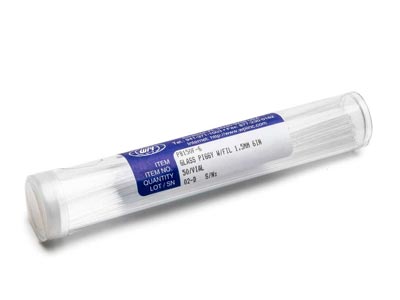WPI offers a wide spectrum of high-quality glass capillaries. We take pride in our ability to ship your glass order within 48 hours. If you need a special glass that does not appear on our website, please call us. We will make every effort to provide it for you.
Fire Polishing
Fire polished glass capillaries are easier to insert into microelectrode holders without damaging the gasket. More importantly, fire-polished glass won’t scratch the chloridized wire used in a recording electrode. Fire-polishing does not affect the glass's mechanical or electrical properties.
Filaments for Quick Filling
Single barrel standard capillaries are offered either with or without inner filaments in a variety of lengths and diameters. The filament is a thin glass rod annealed to the inner wall of the glass capillary. The filament improves the capillary action to avoid air bubble formation inside the capillary. The filament acts like a wick to draw liquid into the microelectrode or micropipette.
Capillary glass with a filament is recommended when you are pulling microelectrodes (electrophysiology) or micropipettes (microinjection) for applications that require tips smaller than 3 µm. Back filling such a pipette is nearly impossible without the filament. Without the filament, you risk the introduction of air bubbles into the pipette.
Configurations of Glass Capillaries
Standard glass is available with or without a filament fused to the inner wall. Filaments aid in the capillary action for the filling of electrodes.
Multi-barrel capillary glass is available in two, three, five and seven-barrel configurations.
A complete range of single barrel thin-wall glass is sold for finer tips and shorter tapers.
A variety of special configurations like septum theta and piggyback glass capillaries are also available.
Understanding Capillary Part Numbers
If you know the code, our part numbers provide the specifications for our glass. For this example, let's consider the 1B150F-4 standard glass capillaries:
- 1B indicates the number of barrels. 1B is single barrel, 2B is 2-barrel, 3B is 3-barrel, etc.
- 150 - The next three digit indicate the outside diameter (OD) of the glass capillary:
• 100 is 1.0 mm OD
• 120 is 1.2 mm OD
• 150 is 1.5 mm OD
• 200 is 2.0 mm OD
- The F in this part number indicates that the glass capillary has a filament annealed to the inner wall. If there is no F in the part number, there is no filament (1B150-4).
- The last number after the dash (-4) indicates that the length of our capillary is 4":
• 3 is 3" glass
• 4 is 4" glass
• 6 is 6" glass
Thin wall glass and specialty glass also conform to this numbering scheme.
- All thin wall glass is single barrel, so thin wall glass part numbers all start with a TW instead of 1B. A typical part number is TW120F-6. This is a thin wall capillary with 1.2 mm OD that includes a filament and is 6" long.
- Septum Theta glass is preceded by TST instead of 1B. For example, TST150-6 is septum theta glass with a 1.5 mm OD that is 6" long.
- Piggyback glass capillaries have part numbers that start with PB instead of 1B. For example, PB150F-4 is piggyback glass with a 1.5mm OD that has a filament in the larger barrel and is 4" long.
Just remember that when you need a filament, look for an F in the capillary glass part number. For example, 1B150F-4 is a single barrel glass capillary with a 1.5 mm ID that includes a filament and is 4" long.

